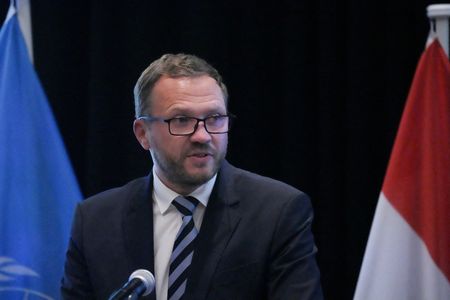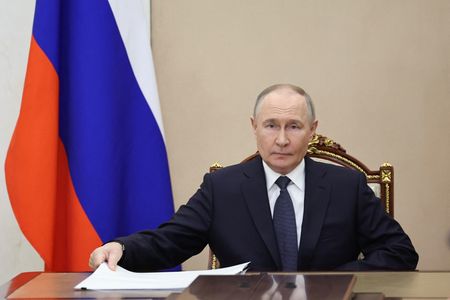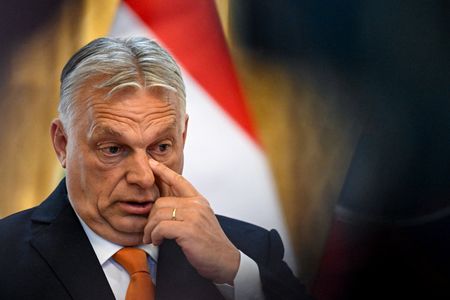By Andrius Sytas and Sabine Siebold
TALLINN/ANTALYA, Turkey (Reuters) – Estonia said on Thursday that Moscow had briefly sent a fighter jet into NATO airspace over the Baltic Sea during an attempt to stop a Russian-bound oil tanker thought to be part of a “shadow fleet” defying Western sanctions on Moscow.
Russia, which regards sanctions as a malign attempt to crush its economy, says all its ships have free passage in the Baltic and any attempt to stop them is dangerous.
Estonia’s navy said the unflagged Jaguar ship, which went onto a UK sanctions list last week, refused to cooperate when asked to stop and was then escorted to Russian waters.
“The Russian Federation sent a fighter jet to check the situation, and this fighter jet violated NATO territory for close to one minute,” Estonian Foreign Minister Margus Tsahkna told reporters in Turkey ahead of a meeting of foreign ministers from the transatlantic military alliance.
“(The) Russian Federation is ready to protect the ‘shadow fleet’… The situation is really serious,” Tsahkna added.
Western nations say Moscow is using a “shadow fleet” of more than 100 ships to dodge sanctions that President Vladimir Putin views as a part of a campaign to quash its global influence.
Moscow sends millions of barrels of oil and fuel every day to buyers in China and India and has warned against any attempt to violate its vessels’ freedom of movement.
The tanker was sailing in international waters, between Estonia and Finland, and refused Estonian navy requests to change course, a spokesperson for the Baltic country’s defence forces later told Reuters.
A Russian SU-35 fighter jet approached the tanker and circled it, flying in international airspace except when it violated Estonian airspace briefly as it first approached the scene, the spokesperson added.
Finland accused Russian ships of behaving recklessly in the area while Lithuania expressed fears of conflict.
“The probability of a serious escalation in the Baltic Sea is growing,” Lithuanian Prime Minister Gintautas Paluckas said.
“Russia is clearly demonstrating that it is ready to protect the route for its oil. We need to act carefully and rationally, so that escalation does not turn into a military clash.”
NATO chief Mark Rutte said the alliance and Estonia were in “close contact” about the incident.
‘FOLLOW MY INSTRUCTIONS’
Estonia said NATO military aircraft had also taken off to inspect the Gabon-listed Jaguar.
It was near Naissaar Island off the Estonian capital Tallinn when the navy communicated with it by radio on Tuesday afternoon, Commander Ivo Vark told Reuters in an email message.
Given it was sailing “without a nationality”, the navy sought to verify its documents and status, Vark said. But when it refused to cooperate and continued towards Russian waters, the navy opted to escort it there with a patrol ship.
On Thursday, the Jaguar was anchored near the Russian port of Primorsk, Marine Traffic data showed.
Footage on X purporting to be filmed from the bridge of the tanker shows an Estonian navy patrol ship, helicopter and aircraft nearby. An identification number seen in the video matches the Jaguar.
“This is Estonian warship … follow my instructions, alter your course to 105 immediately,” a voice in English sounds over a radio.
“We are met by helicopters, they demand we go on anchor,” says another voice in Russian off-camera.
Another voice, in Hindi, says: “The plane is on top of us. It’s either an aircraft or a drone. The military ship is turning towards the stern of the vessel.”
A military jet, which Estonia does not operate, is also glimpsed flying nearby.
On X, Margarita Simonyan, head of Russia’s state media outlet RT, who posted the video, said the figher jet was sent to prevent the vessel’s seizure.
Authorities in Gabon did not immediately comment on Estonia’s assertion that the ship is on their registry.
In another incident on April 11, Estonia detained and boarded a Russia-bound oil tanker, Kiwala, accusing it of sailing without a valid country flag. The tanker was released two weeks later after Djibouti confirmed its registry.
Kremlin aide Nikolai Patrushev told the Kommersant newspaper last month that Russia’s navy was ready to protect its ships.
“Hotheads in London or Brussels need to understand this clearly,” he said, adding that Western efforts to block Russian ships were beginning to resemble a “naval blockade”.
It was unclear if Estonia acted on its own initiative or on a request from NATO. Washington is pushing hard for a Russia-Ukraine peace deal, with U.S. President Donald Trump saying he could rachet up sanctions if Moscow refuses to cooperate.
(Reporting by Andrius Sytas in Tallinn and Sabine Siebold in Antalya; Additional reporting by Dmitry Zhdannikov in London, Supantha Mukherjee in Stockholm, Andrew Gray in Brussels, Gerauds Wilfried Obangome in Libreville; Writing by Andrius Sytas and Gwladys Fouche; Editing by Clarence Fernandez, Andrew Cawthorne and Gareth Jones)













